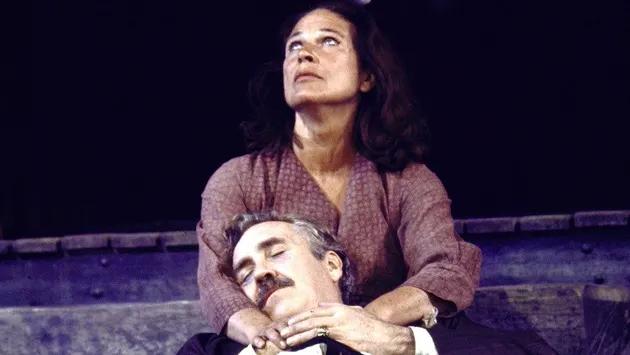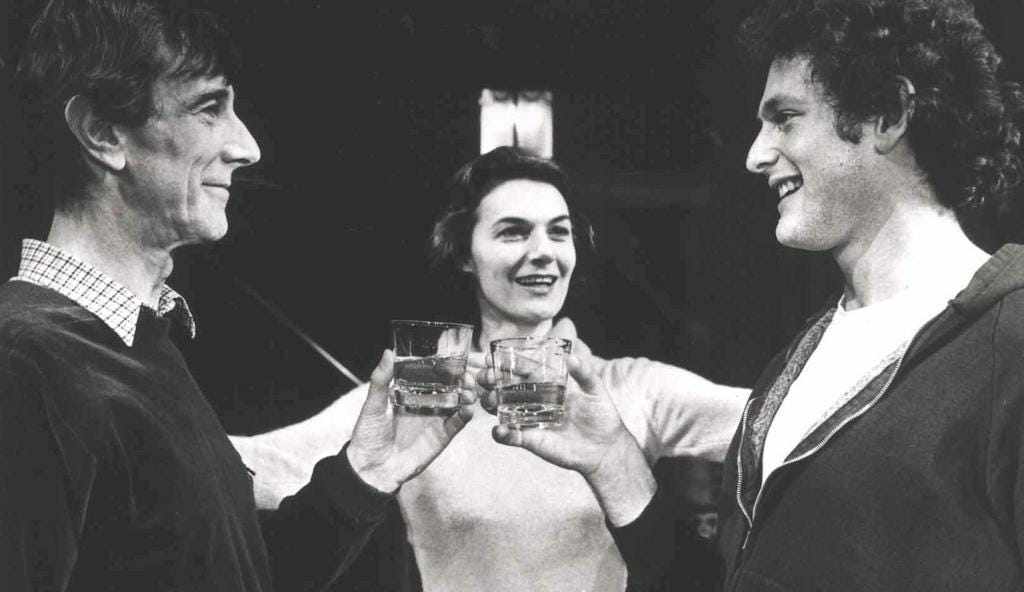
With My Fair Lady turning sixty-five today, does it mean this world-favorite musical has reached retirement age? With no such mandatory restrictions in the theatre it might seem a frivolous question, yet in some cases, a show can wear out its welcome over many decades. Has time been kind to one of the most successful of the Golden Age of Musicals? A subject for today's "Theatre Yesterday and Today."
In 2018, when the first Broadway revival of My Fair Lady in a quarter-century opened at Lincoln Center, it had more than a few purists up in arms, offering as it did an update here and there, the omission of a line or two, and an unusual take on its ending. Arguments centered not only on these so-called improvements, but on whether any rethinking was necessary at all for a musical that was already revered in an opening night review in 1956 as "a legendary evening."* But with a host of social issues that have become part of the conversation today no one could have imagined then, it feels as if there needs to be reminding that MFL was always a period piece and was never meant to reflect contemporary values. Compare them, yes. Three years ago when director Bartlett Sher tinkered with his revival, classical theatre was already tiptoeing through potential landmines (a decidedly scared-of-its-own-shadow Carousel had opened on Broadway just one week earlier) with changes few thought were for the better. And just consider last week's dual announcements about sending both a Warner Brothers cartoon character and drawings by Dr. Seuss to the trash due to certain perceived insensitivities.
Yes. I'm worried whether Henry Higgins will be the next Pepe LePew.
Of course, at sixty-five, My Fair Lady is relatively young compared to its source, George Bernard Shaw's Pygmalion, which had its premiere (in German) at the Hofburg Theatre in Vienna on October 16, 1913. Six months later it had its American premiere (also in German) on New York's Lower East Side. One of the reasons London didn't get the production first was due to Shaw having written the role of Eliza Doolittle expressly for the actress Beatrice Stella Campbell (1865-1940), known professionally as Mrs. Patrick Campbell. Unavailable when first shown the play, she made her debut in a production directed by Shaw himself — April 11, 1914— at the age of forty-nine, such was her star power and status with the British public. Interesting note: she and Shaw conducted a brief, yet passionate love affair at this time (though unconsummated), proof of which exist in their letters, which weren't published until 1952, two years after the playwright's death.

Being over a hundred years old, Pygmalion is a tot compared to its source: an ancient Greek myth well known by virtue of the Roman poet Ovid’s Metamorphoses who repurposed it in 8 AD. As the tale goes, Pygmalion was an artist who supposedly sculpted an ideal woman — only to fall in love with the statue. This was the take-off point for Shaw, whose idea it was that Henry Higgins “sculpts” Eliza, a common flower girl into someone he could pass off as a duchess due to his ability to alter her speech and bearing, which represented to him — and to then society's image — of an ideal woman. Although Higgins’s love is never boldly declared, his declaration at having “Grown Accustomed to Her Face” is one of My Fair Lady's most appealing strokes of genius musically (and lyrically, a lift straight out of Shaw's dialogue).

This was part of what librettist Alan Jay Lerner accomplished in his adaptation which many who came before him thought impossible. He took Shaw’s essentially unromantic story and turned it into something ravishingly romantic without changing a thing (the lush score by his partner Frederick Loewe was also a decisive factor). Lerner didn’t even have to rework Pygmalion’s dour ending, as it had already been changed for the 1938 film adaptation, produced in Shaw’s lifetime and penned by Shaw himself (with three others credited as well), for which all shared an Academy Award for Best Adapted Screenplay. However, Shaw was livid at the tacked-on ending, done without his approval, which allowed for the hint of a potential romance between Higgins and Eliza without doing anything explicit to suggest it. This would also serve as the finale for MFL, both in its original Broadway production and its Academy Award winning film version in 1964.

Shaw's preferred ending to Pygmalion is almost brutal in its un-romanticism. After building up a mutual attraction between its protagonists for an entire evening, the playwright almost delightfully pulls the rug out from under what its audience both wants and expects — that Eliza and Higgins figure out they need one another in their lives. The last line, spoken by Higgins after a fight where Eliza once and for all announces she'll have nothing to do with him, has him declare to his mother that she'll be back. Referring to a pair of gloves he had asked her to pick out for him (and to which she refuses), Higgins remarks that "she'll buy em all right enough," slyly mispronouncing "them" with "em." In a later improvement over this ending, and one done for years thereafter, Pygmalion would end with a line out of the lengthy essay Shaw wrote as an epilogue to the printed edition of the play, answering the question everyone wanted to know whether Higgins and Eliza wind up together. "Nonsense. She's going to marry Freddy," Higgins delightedly smirks, laughing as the curtain falls (it can be seen in a 1983 televised version that had starred Peter O'Toole in the West End and on Broadway). That laughter can get stuck in Higgins’s throat (or not), again, totally open to interpretation.
It is important to note, however, that with this ending Shaw is being true to the source of the play's myth and legend. As he points out in the final line of his aforementioned postscript: "Galatea never does quite like Pygmalion: his relation to her is too godlike to be altogether agreeable."
The My Fair Lady ending, as mentioned based on the one in the 1938 film of Pygmalion, has Eliza returning to Higgins's study after the fight where she asserts her independence. The audience is ready for Higgins to embrace her either physically or by saying something to endear himself to her for his poor behavior, but instead, he inquires "Eliza, where the devil are my slippers?," a callback to a previous scene and loaded with whatever the actors portraying both Higgins and Eliza want to do with it. I won't enumerate the dozens of ways this has been done (everything from the two of them laughing over it to the curtain coming down and then rising again as a sort of double-emphasis of the electrically charged moment, as it did in the first Broadway revival in 1976, which was extremely effective).

As New York Magazine theatre critic Sara Holdren wrote in her review of the 2018 revival: "What adds bittersweet nuance to My Fair Lady, though, is that Henry Higgins is also a fantastic character, and whatever Shaw may have intended, there’s certainly something between him and Eliza." Holdren liked what Bartlett Sher did in that production’s final scene where, without changing a word, a pantomime was concocted in which after asking where the devil his slippers are (with true regret over not being capable of saying anything else), and in a gesture of forgiveness as well as defiance, Eliza takes Higgins's face in her hands to wordlessly say goodbye. She then breaks the fourth wall of the theatre and marches out of the study and up the aisle of the theatre while the orchestra stirringly plays a reprise of the crashing chords of "I Could Have Danced All Night."
What crossed my mind when I saw it was its echoing the famous last moment of Henrik Ibsen's A Doll's House when its protagonist, Nora Helmer, slams the door on her life and leaves her husband in stunned silence. I appreciated Sher's theatricality and had no issue, as some critics did, with his breaking the fourth wall, but I did question the logic, as it felt very much like a repeated beat. Why would Eliza come all the way back only to say goodbye again, which she had just done in the previous scene at Higgins's mother's house? In that way, the coda felt tacked on and superfluous, even if emotionally it wasn't altogether wrong. I strongly feel it's not in any director's best interest squeezing round pegs into square holes, especially as the last thing one sees before the blackout.
More importantly, was it necessary? If the point was to hammer home Eliza's moxie, wasn't this hitting the nail on the head too directly? It is only in theory that Higgins proposes he can make a "duchess of this draggle-tailed guttersnipe" in the play's opening scene. It is Eliza who takes a taxi to his home to ask for lessons, "willing and ready to pay" and put the scheme into action. It is she who puts the entire plot into motion on her own, achieves her success through hard work and determination and, from the outset, is no shrinking violet.
In other words, Shaw took great pains to establish Eliza's independence as did Lerner, along with My Fair Lady's first director, the estimable Moss Hart. And though Mr. Sher's intentions were sincere and well-executed by the actors Lauren Ambrose and Harry Hadden-Paton, it felt very much like gilding the lily. After all, it's hard to improve something that is damn near pretty perfect — and ageless.

* William Hawkins, World-Telegram & Sun, March 17, 1956
If you enjoy these columns, check out Up in the Cheap Seats: A Historical Memoir of Broadway, available at Amazon.com in hardcover, softcover and e-book. And please feel free to email me with comments or questions at Ron@ronfassler.org.





















Write a comment ...